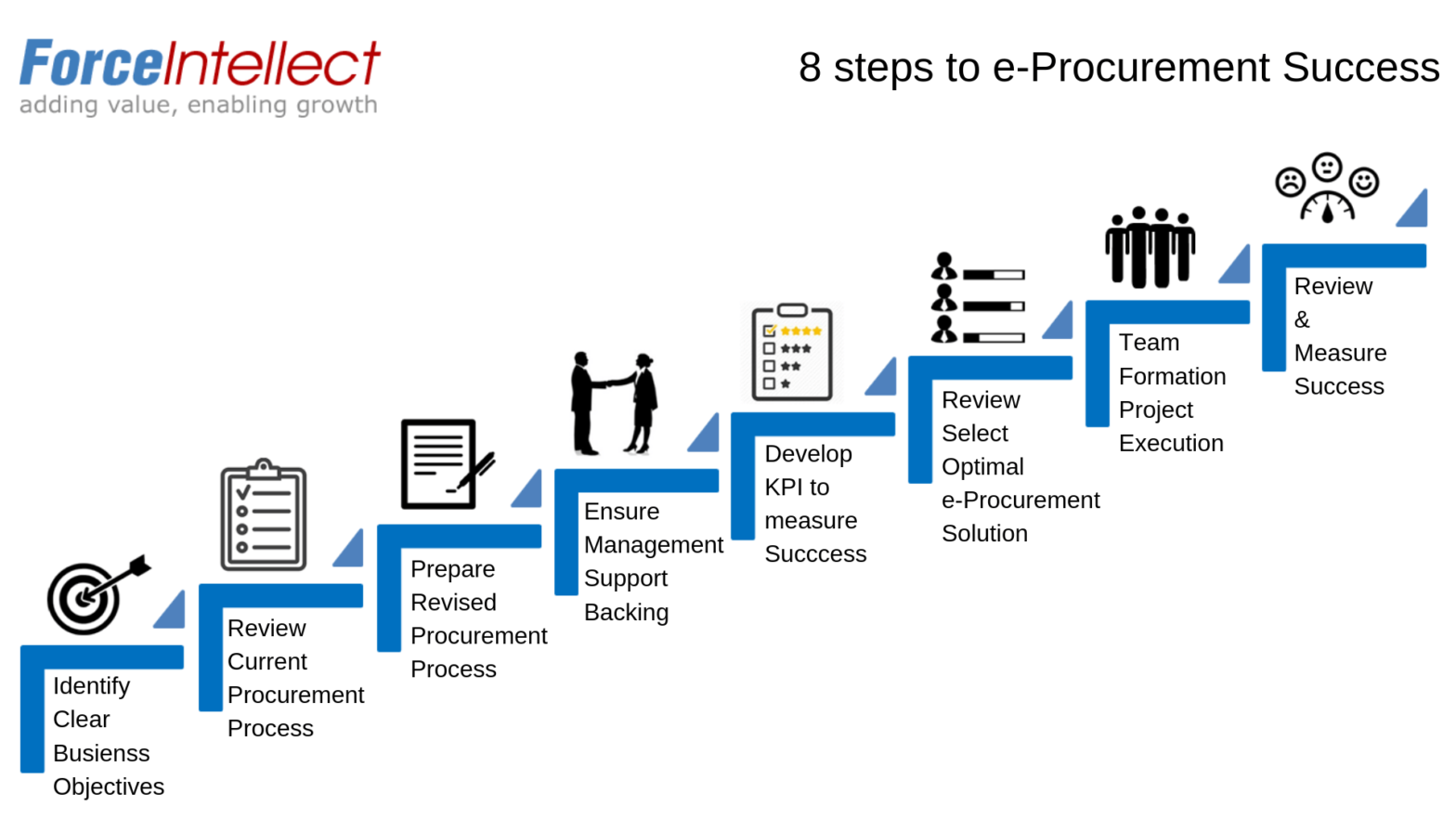8 Steps to eProcurement Success
Do you want to save time, effort and procurement costs? Have you noticed that manual procurement process is person dependent, involves a lot of paperwork, repetitive tasks and is time-consuming? “8 steps to eProcurement Success” is a methodology to transition to eProcurement.
Redefine Procurement! Digitize & Automate your procurement process with an e-Procurement software solution.
e-Procurement or electronic procurement refers to the purchase of goods or services online. Implementing e-Procurement in an organization involves automating the procurement process, using a suitable software solution. A well thought implementation methodology will ensure the success of eProcurement implementation.
We present you the ultimate guide to e-Procurement success. We have covered each & every aspect to be considered before deciding in favor of eProcurement, during the process of transition to e-Procurement and measurement criteria to ensure eProcurement success after implementation.
Step 1 – Identify Clear business objective
 Like any other IT project, organizations you must identify clear business objectives you want to achieve through eProcurement. A clear business objective helps you in defining the strategy and plan that ensures success.
Like any other IT project, organizations you must identify clear business objectives you want to achieve through eProcurement. A clear business objective helps you in defining the strategy and plan that ensures success.
Step 2 – Review your current procurement process
 First, please document and analyze your current procurement process. Evaluate the current process against your current business requirements and objectives. Thus, you will be able to identify gaps in your current procurement process and areas of improvement for the same.
First, please document and analyze your current procurement process. Evaluate the current process against your current business requirements and objectives. Thus, you will be able to identify gaps in your current procurement process and areas of improvement for the same.
Step 3 – Prepare Revised procurement strategy
![]() When you write your revised procurement strategy, keep in mind that the procurement process involves collaboration with people within and outside the organization. Hence consider the internal factors, external challenges, technology, people skills, etc while developing your realistic strategy for eProcurement. Your revised procurement policy should help achieve business objectives.
When you write your revised procurement strategy, keep in mind that the procurement process involves collaboration with people within and outside the organization. Hence consider the internal factors, external challenges, technology, people skills, etc while developing your realistic strategy for eProcurement. Your revised procurement policy should help achieve business objectives.
Step 4 – Ensure Management Support Backing
![]() Implementing eProcurement in your organization will require the support & backing from all stakeholders within & outside the Organization. When your Management team endorses and encourages this project, eProcurement project will get the requisite priority, required resources and active participation from all stakeholders.
Implementing eProcurement in your organization will require the support & backing from all stakeholders within & outside the Organization. When your Management team endorses and encourages this project, eProcurement project will get the requisite priority, required resources and active participation from all stakeholders.
Step 5 – Develop Key Performance Indicators to measure success (KPI) of eProcurement
 You should develop Key performance indicators (KPI) against each objective to measure the success of eProcurement implementation. KPIs also ensure better collaboration among teams to achieve the target. Good KPIs provide a real-time status update against each objective. This helps to identify the area of improvements for the success of the implementation.
You should develop Key performance indicators (KPI) against each objective to measure the success of eProcurement implementation. KPIs also ensure better collaboration among teams to achieve the target. Good KPIs provide a real-time status update against each objective. This helps to identify the area of improvements for the success of the implementation.
Step 6 – Review & select the optimal eProcurement solution
 You have defined your Procurement objectives, prepared a revised procurement strategy, obtained your management approval, and determined KPI to measure the implementation success. Now, is the time to evaluate eProcurement Software solution vendors based on your selection criteria and shortlist vendors that meet your requirements.
You have defined your Procurement objectives, prepared a revised procurement strategy, obtained your management approval, and determined KPI to measure the implementation success. Now, is the time to evaluate eProcurement Software solution vendors based on your selection criteria and shortlist vendors that meet your requirements.
Schedule a demo to get real-time experience of eProcurement solution. Further, you can compare quotes from different vendors and ask for references to select an optimum eProcurement software solution.
Step 7 – Team Formation and Project Execution
 You should prepare a well-thought project plan and ensure active participation from team members to ensure the success of eProcurement implementation. Create a joint action plan along with vendors for the roll-out of eProcurement solution. Identify and assign key persons responsible for every task. Set up the infrastructure, conduct training, and knowledge transfer activities, collect and implement feedback. Carry out acceptance testing before rolling out the eProcurement software solution.
You should prepare a well-thought project plan and ensure active participation from team members to ensure the success of eProcurement implementation. Create a joint action plan along with vendors for the roll-out of eProcurement solution. Identify and assign key persons responsible for every task. Set up the infrastructure, conduct training, and knowledge transfer activities, collect and implement feedback. Carry out acceptance testing before rolling out the eProcurement software solution.
Step 8 – Review and measure e-Procurement success
 Post-implementation you should check how well the objectives have been met. Conduct a satisfaction survey and get feedback from all the stakeholders involved. Collect feedback and find further areas of improvements.
Post-implementation you should check how well the objectives have been met. Conduct a satisfaction survey and get feedback from all the stakeholders involved. Collect feedback and find further areas of improvements.
Conclusion
To ensure e-Procurement success, you should have clear business objectives, defined processes, sufficient resources, and realistic expectations. You should select the right eProcurement solution, proper implementation plan, execution of training program and post-implementation activities.
Request a Demo of Force Intellect eProcurement Solution

